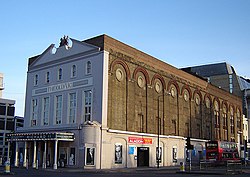
Back فيك القديم ARZ Old Vic Theatre Catalan Old Vic Czech Old Vic Theatre German Ολντ Βικ Greek Old Vic Spanish Old Vic Basque اولد ویک Persian Old Vic Finnish Théâtre Old Vic French
Royal Coburg Theatre Royal Victoria Theatre Royal Victoria Palace Royal Victoria Hall and Coffee Tavern | |
 The exterior of the Old Vic from the corner of Baylis Road and Waterloo Road | |
 | |
| Address | The Cut London, SE1 England |
|---|---|
| Coordinates | 51°30′08″N 0°06′35″W / 51.5022°N 0.1096°W |
| Public transit | |
| Owner | Old Vic Theatre Trust 2000 |
| Designation | Grade II* listed |
| Type | Non-commercial theatre |
| Capacity | 1,067 |
| Construction | |
| Opened | 1818 |
| Rebuilt | 1871: J. T. Robinson 1880/1902: Elijah Hoole 1922/1927: Matcham & Co.,(under F. G. M. Chancellor)[1] 1933–38: F. Green & Co 1950: Pierre Sonrel 1960: Sean Kenny[2] 1983: Renton, Howard, Wood & Levine |
| Years active | 1818–present |
| Architect | Rudolphe Cabanel of Aachen |
| Website | |
| oldvictheatre.com | |
The Old Vic is a 1,000-seat, nonprofit producing theatre in Waterloo, London, England. It was established in 1818 as the Royal Coburg Theatre, and renamed in 1833 the Royal Victoria Theatre. In 1871 it was rebuilt and reopened as the Royal Victoria Palace. It was taken over by Emma Cons in 1880 and formally named the Royal Victoria Hall, although by that time it was already known as the "Old Vic". In 1898, a niece of Cons, Lilian Baylis, assumed management and began a series of Shakespeare productions in 1914. The building was damaged in 1940 during air raids and it became a Grade II* listed building in 1951 after it reopened.[3]
The Old Vic is the crucible of many of the performing arts companies and theatres in London today. It was the name of a repertory company that was based at the theatre and formed (along with the Chichester Festival Theatre) the core of the National Theatre of Great Britain on its formation in 1963, under Laurence Olivier. The National Theatre remained at the Old Vic until new premises were constructed on the South Bank, opening in 1976. The Old Vic then became the home of Prospect Theatre Company, at that time a highly successful touring company which staged such acclaimed productions as Derek Jacobi's Hamlet. However, with the withdrawal of funding for the company by the Arts Council of Great Britain in 1980 for breaching its touring obligations, Prospect disbanded in 1981. The theatre underwent complete refurbishment in 1985. In 2003, Kevin Spacey was appointed artistic director, which received considerable media attention.[4] Spacey served as artistic director until 2015; two years after he stepped down, he was accused (but later found not liable) of sexually harassing and assaulting several people.[5] In 2015, Matthew Warchus succeeded Spacey as artistic director.[6]
- ^ Historic England, "Old Vic Theatre (1068710)", National Heritage List for England, retrieved 2 September 2020
- ^ "Kenny, Sean, 1932–1973". National Art Library Catalogue. Victoria and Albert Museum. Archived from the original on 1 August 2013. Retrieved 20 June 2022.
- ^ English Heritage listing details 28 April 2007
- ^ "Spacey 'to run Old Vic'". BBC News. 3 February 2003. Archived from the original on 20 March 2021. Retrieved 9 March 2014.
- ^ Clarke, Stewart (16 November 2017). "Old Vic Theater Logs 20 Complaints About Kevin Spacey, Pledges to Improve Accountability". Variety. Los Angeles, California: Penske Media Corporation. Archived from the original on 20 March 2021. Retrieved 17 February 2019.
- ^ Brown, Mark (22 May 2014). "Matthew Warchus to take [Kevin Spacey's role running the Old Vic". The Guardian. Archived from the original on 3 March 2016. Retrieved 22 June 2016.